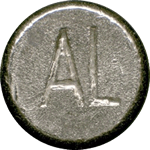- 01: Introduction
- 02: History
- 03: Propellants, Firearms, and Ammunition Development
- 04: Modern Firearms Manufacture
- 05: Small Arms Ammunition
- 06: Evidence Handling Procedures
- 07: Equipment and Instrumentation
- 08: Examination of Firearms
- 09: Cartridge and Shotshell Examination
- 10: Characterization and Evaluation of Fired Projectiles
- 11: Bullet Comparison and Identification
- 12: Gunshot Residue and Distance Determination
- 13: Toolmark Identification
- 14: Communicating Results
- Resources


Rimfire
Home > Small Arms Ammunition > Cartridge Case Manufacture > Rimfire
Rimfire cases start as rolled, thin sheets of cartridge brass, which are mounted and fed through rollers to reflatten them.
The sheet moves into a cupping press that
- lubricates the sheets,
- blanks out disks of brass,
- drives the disks into a cupping die to form shallow cups.

Click here to watch a video on the cupping press
A draw press reduces the diameter and increases the length of the cup in the same manner as copper bullet jackets. The punch and die set in the draw press captures all surfaces of the cup except the base (closed end) and stretches the brass to the desired diameter. The drawn length is longer than that required for the finished case to allow trimming the case mouth to uniform length. The inside of the case mouth may be beveled during trimming to facilitate bullet seating.
At this point, the case has a finished diameter and case mouth, but the closed end is not shaped into a functional case head. The heading operation shapes the closed end using a press called a header.

Rimfire headstamp - Airline brand
Heading accomplishes the following:
- Forms the rim and rim cavity (for holding the priming charge)
- Sets the rim diameter
- Sets the rim thickness
- Sets the final case length
- Applies the identifying headstamp
In most factories, all of the heading processes can be accomplished in a single operation. The case is held securely in a stationary die; an inner back-up punch and an outside forming punch come together to apply the required force. The outer punch (bunter) has raised characters on the punch that impress the headstamp into the base.
After cold working, the brass may have residual stresses, which may affect the long-term performance and safety of the case. This contributes to age hardening. Stress relief ovens raise the metal temperature enough to relax the stresses without changing the grain structure of the case.
The rimfire case is fully formed, but covered in oils that could contaminate the priming compound. Washing removes these oils, leaving water in its place. The cases must be oven dried to remove all traces of moisture.




